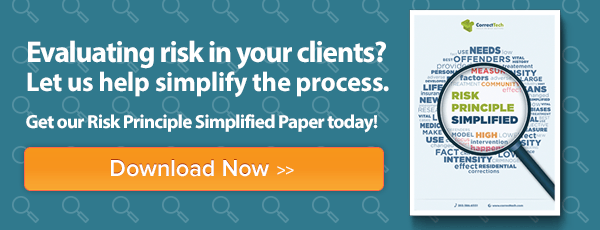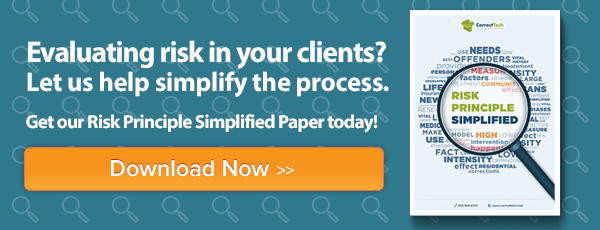Subscribe to our blog and get the next series delivered right to your inbox.
Trust Is Like Air
I do not personally know most of you, but I’d like to take a stab at your latest marching orders from above. Does it sound something like this? Implement EBP now!
Pretty simple right? Use the NIC model (or stay tuned for the release of CorrectTech’s revised model soon) and implement the stated principles ASAP. It can’t be that difficult, right? Community Corrections has been talking about evidence based practices for decades now. Time to walk the talk! It will improve outcomes, public safety, communities and budgets. It is a win-win-win.
Are We Losing Credibility?
If this has not been your marching order yet, it will be soon. Day 1 will include googling something like “community corrections EBP implementation”. You will find a variety of states and programs that speak eloquently about the value of EBP, but have not been able or willing to actually take the leap. You will find other states that have demonstrated significant progress in the implementation journey. Still other states or agencies have tried desperately for years, with sincere intentions and ample resources, only to be met with lack of results that meet up with the promise. No wonder it is not uncommon to hear an old school criminal justice professional refer to EBP evangelism as “drinking The Kool Aid” or the “Latest Snake Oil”.
As a practitioner going at it for over a decade now, I believe the EBP movement is at risk of losing credibility and its calling card of “being the unifying plan of action”. It is beginning to look like we are long on theory and short on execution. It is beginning to look like changing the community corrections systems to revolve around the common sense evidence based principles (for a summary see our EBP Simplified white paper) is too difficult of a task? Most EBP implementation attempts fall well short of “the talk.” Is EBP that hard to understand? Is it that difficult to implement? It all depends on you. I have no doubt that implementation science will provide fruit down the road, but if we don’t successfully implement EBP now, our replacements will.
Making Rookie Mistakes
EBP implementation is still in the infancy stage, and our well intentioned industry is, not surprisingly, making lots of beginner mistakes. We want to change the system’s behavior so badly and for all the right reasons. Not unlike a new therapist with a passion for working with offenders. Having read everything available and quite sure they understand where everyone else has missed the boat, they are ready to jump in with both feet. With a few questions (i.e., assessment), they have all of the answers (i.e., targeted interventions). They have learned Motivational Interviewing and are certified in 13 different cognitive-behavioral training programs. They have such a good plan that it is possible that they will work themselves out of a job in about six months! Ready, fire, aim. There is no time to waste.
Unfortunately, the eager therapist, drunk with passion, is about to run head first into a brick wall. When we are convinced that we have all of the answers, sometimes we forget to slow down to gain the trust of our client. Because the intervention is so obvious to us, we assume it is equally obvious to others. We often develop plans on how other people will change without having ever met that person yet. Our intentions are certainly good. That, however, does not excuse the poor execution.
 Trust Is Like Air
Trust Is Like Air
“Trust is like the air that we breathe. When it is present, nobody notices. When it is absent, everybody notices,” says Warren Buffett, this generation’s greatest stock investor. Clever quote, but are Mr. Buffett’s stock investing lessons really applicable to our attempts to implement EBP in community corrections? Great question. Buffett has been interviewed extensively about his investing philosophy. His primary barometer of a company that will be successful in the future? Trust. Do the stockholders trust the company? Do the employees trust the company? Do customers trust the company? Stock investing is essentially about predicting the future and, according to Warren Buffett, the best way to do that is to assess trust.
Building the Relationship
While I am sure that some will believe it sacrilegious, there is no doubt in my mind that the most important principle of effective intervention in our forthcoming revised EBP process model is the first one, Building the Relationship. More important than assessment? Yes. More important than positive reinforcement? Yes. More important than community involvement? Yes. (Send angry emails to etumperi@correcttech.com). Trust is like air. When it is absent, it will be the ONLY focus.
Most seasoned therapists are highly attuned to creating trust and building the therapeutic relationship with a client. When the relationship is full of trust, it creates a multiplier effect. In other words, the value of a good relationship is greater than the sum of its parts. Creativity, energy, and concentration grow out of a healthy, positive relationship. The opposite is equally true. In fact, the presence of resistance and negativity signifies the absence of a trusting relationship. This is a truism whether working with an individual or a group of individuals. So…how does one go about building a trusting relationship with a system or group of stakeholders? The process of building a trusting relationship is the same whether the behavior change target is a convicted felon with a long history of drug use and technical violations or the criminal justice system that manages that offender.
Systems Are People Too
Systems are simply a collection of individuals and their behaviors. Like individuals, systems have values. They have goals. Habits, good and bad, are abundant. Aspirations are important. Systems develop personalities just like individuals, out of a combination of goals, environment, and experiences. When we understand the direction of and power of these influences and can align with them, trust comes easy. When false assumptions, silent agendas, and fear of change drive a system’s behavior, the process of building trust feels like climbing a mountain in the rain wearing flip flops with baby oil on your feet. Misaligned values are the primary reason for resistance. If one of the parties is digging in their heels, one of the following perspectives is dominating their attention:
-
“This person or persons do not have my best interest at heart.”
-
“The person or persons do not understand my needs or goals.”
Building TRUST requires the following:
-
Time: It takes the amount of time that it takes. Attempting to rush the process actually slows it down.
-
Respect: Honor their desires, abilities, values (see our blog about values here) and needs
-
Understanding: What drives them? What makes them get up in the morning? Who is important to them?
-
Sincerity: Honesty, authenticity, genuineness
-
Teamwork: Collaboration, partnership, shared decision making, transparency
So – what does this have to do with my EBP Implementation?
Frustrated with your EBP implementation efforts? Your problem may be that you did not take the necessary time to build trust before pushing change. The behavioral health literature rightfully emphasizes the importance of the therapeutic relationship. In our eagerness to start change, we sometimes forget that motivating a group of people (i.e., agencies or systems) is the same process as motivating an individual client. If system resistance is keeping you awake at night, this is likely the root of the problem. Does that mean that all of your work has been wasted? No. Your current plans will, no doubt, have a great deal of value…after you have the system’s trust.
This all seems like a resource drain. Can you skip the trust building/relationship building stage and just get to the meat of the issue? Sure you can! Your replacement will learn from your mistakes and start with trust.
Subscribe to our blog and get our future posts delivered right to your inbox.



